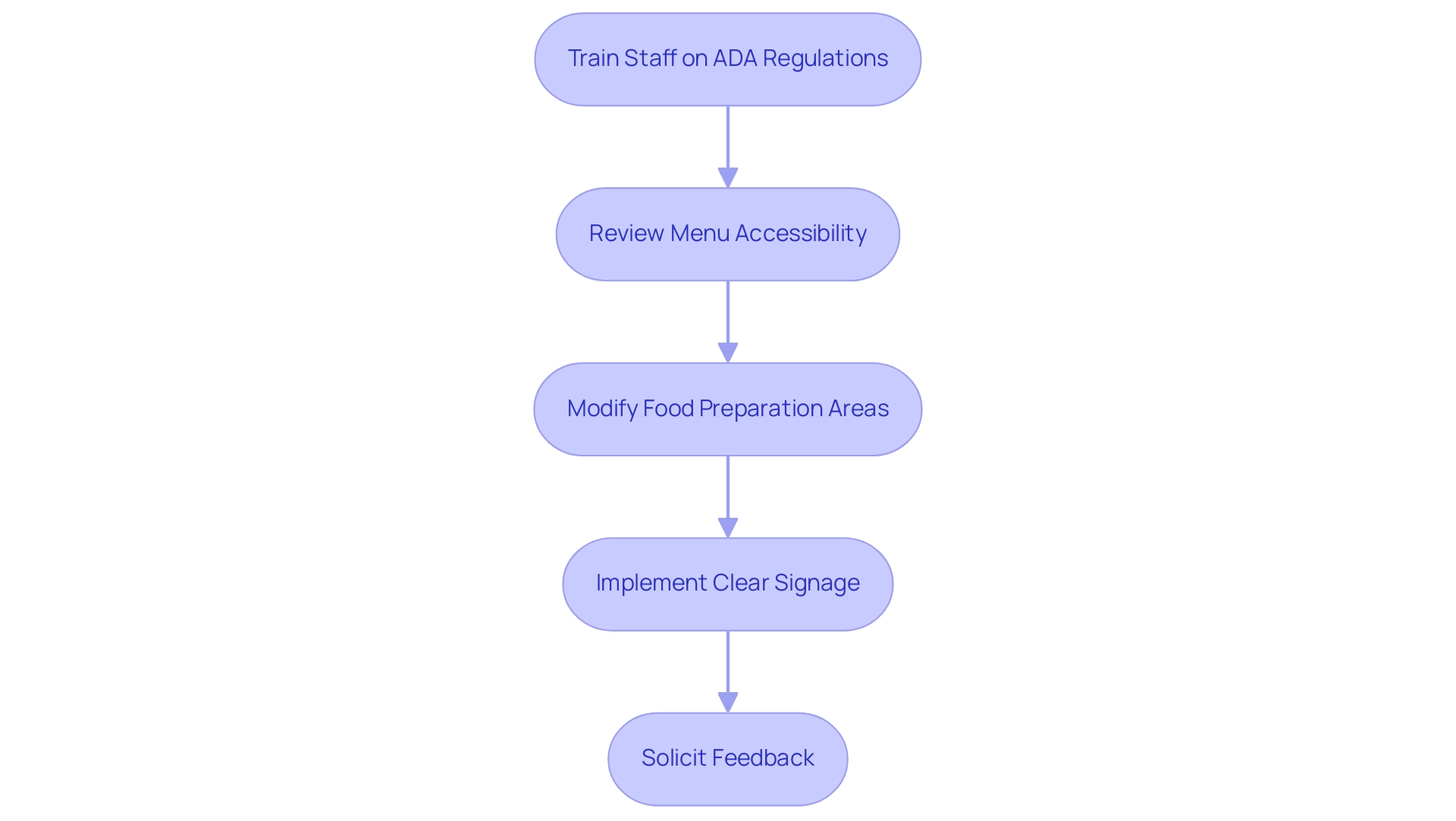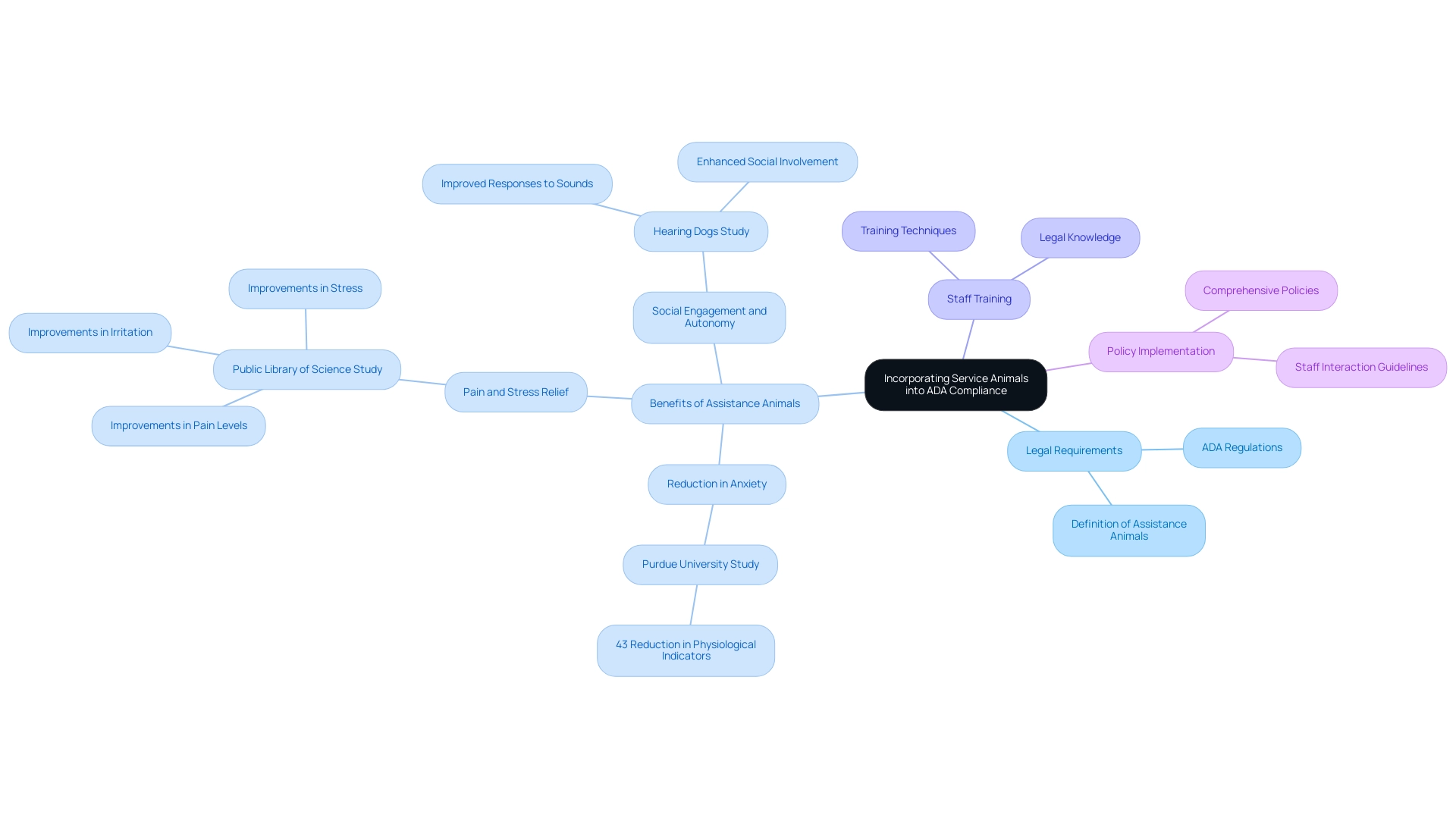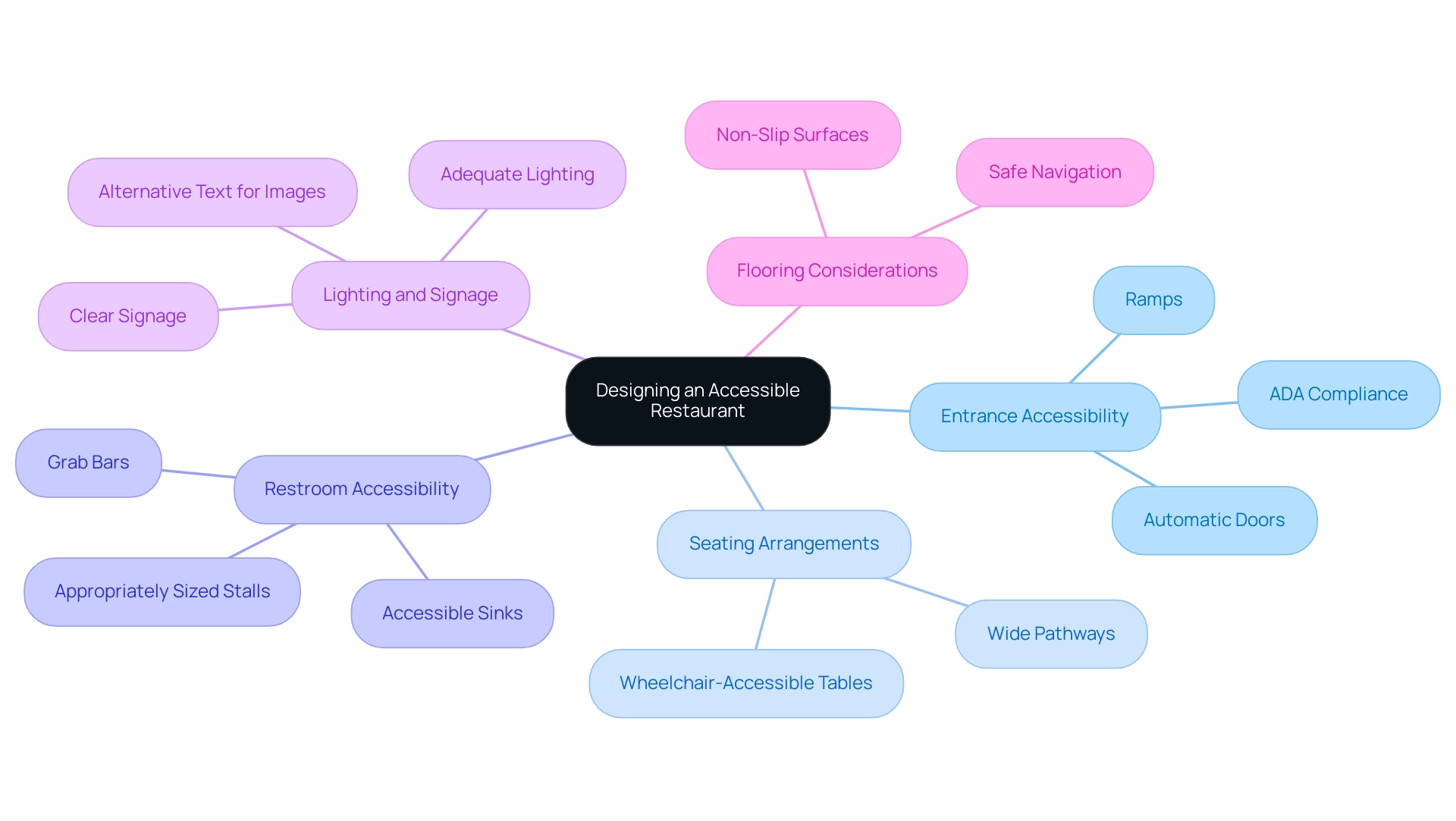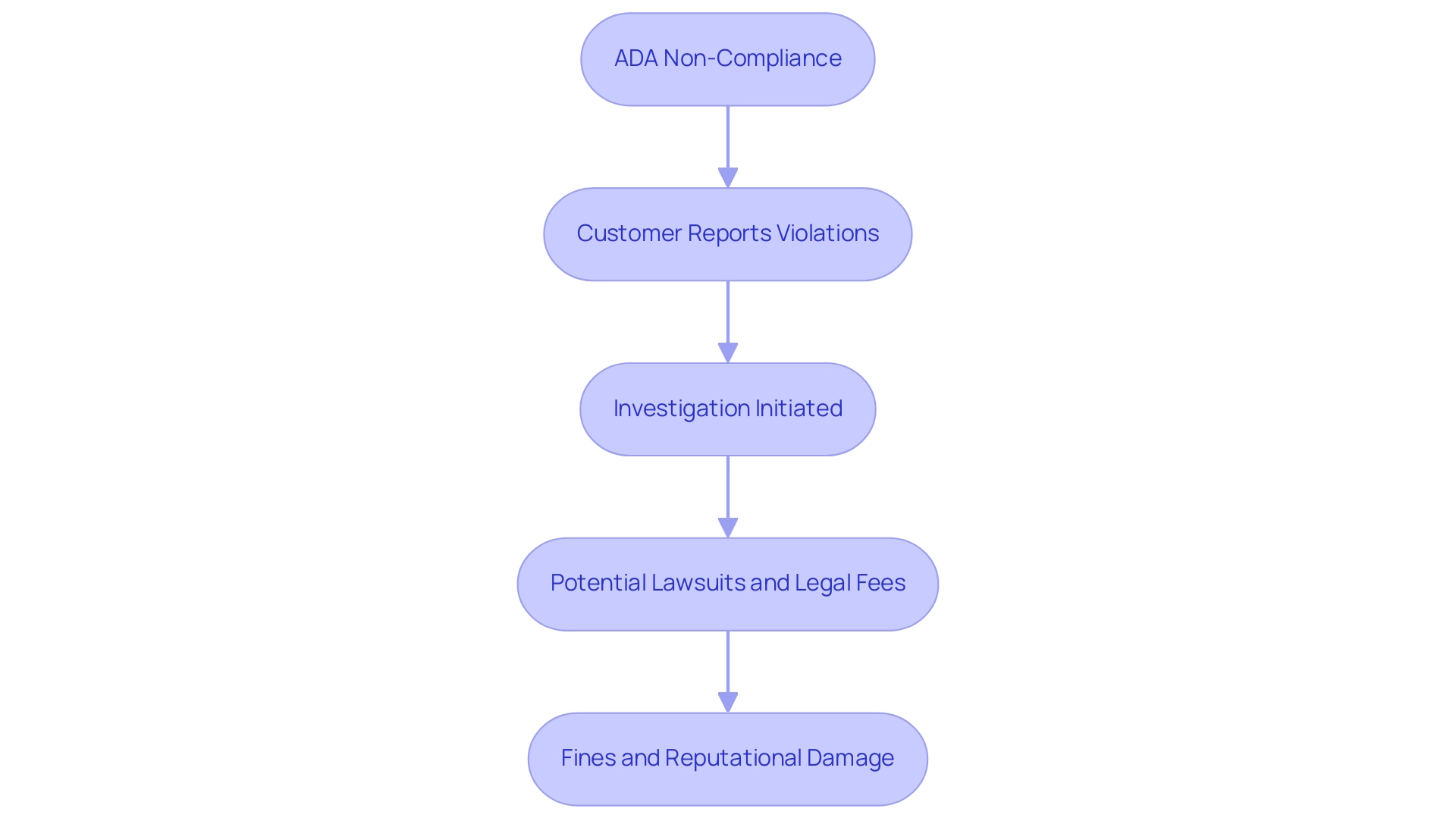Overview:
The article "7 Essential ADA Food Compliance Tips for Restaurants" focuses on providing practical strategies for restaurants to ensure compliance with the Americans with Disabilities Act (ADA) and create an inclusive dining environment. It outlines essential steps such as training staff on ADA regulations, reviewing menu accessibility, and ensuring proper restaurant layout, emphasizing that these measures not only fulfill legal requirements but also enhance customer satisfaction and loyalty by fostering inclusivity for individuals with disabilities.
Introduction
Creating an inclusive dining experience is not merely a legal obligation under the Americans with Disabilities Act (ADA); it is a vital aspect of modern restaurant operations that can significantly enhance customer satisfaction and loyalty. With a substantial portion of the population living with disabilities, the importance of accessibility in restaurants cannot be overstated.
From ensuring physical spaces accommodate all patrons to providing menus that cater to diverse needs, restaurants have a unique opportunity to foster an environment where everyone feels welcome. This article delves into the critical aspects of disability accommodations in the restaurant industry, offering practical tips for achieving compliance, understanding the role of service animals, and exploring the legal implications of non-compliance.
By prioritizing accessibility, restaurants not only adhere to regulations but also unlock the potential for a broader customer base and a thriving business.
Understanding the Importance of Disability Accommodations in Restaurants
Accommodating diners with disabilities is not only a legal obligation under the Americans with Disabilities Act (ADA) but also a moral imperative for dining establishments. According to recent Statistics Canada data, more than a third of New Brunswickers are living with a disability, emphasizing the need for inclusive dining experiences. To meet accessibility requirements, dining establishments should provide a minimum width of 36 inches for maneuvering space in self-service areas, with a preferred width of 42 inches.
Haley Flaro, executive director of Ability New Brunswick, states, "More than a third of New Brunswickers are living with a disability, according to the latest Statistics Canada data," highlighting the significant market that dining establishments can tap into. By providing accessible options, establishments can attract a broader customer base and foster an inclusive environment. It is essential for dining establishments to understand the specific needs of individuals with disabilities, including:
- Mobility impairments
- Visual impairments
- Dietary restrictions
For instance, the rise of dementia-friendly tourism showcases how accommodations can enhance the quality of life for affected individuals, illustrating the positive impact of inclusivity. Restaurants that prioritize these accommodations not only enhance the dining experience for all patrons but also ensure that no one feels excluded due to their circumstances. The benefits of accessible dining extend beyond compliance; they can significantly improve customer loyalty and satisfaction, ultimately contributing to a thriving business.

Practical Tips for Achieving ADA Food Compliance in Your Restaurant
-
Train Staff on ADA Regulations: It is crucial for all dining establishment employees to be well-versed in the Americans with Disabilities Act (ADA) requirements. Regular training sessions enhance awareness and service quality, ensuring that staff can effectively assist guests with disabilities. According to the 2023 Operations Report, training was the top response from operators when asked how they plan to reduce food costs in the next 12-18 months. This highlights the importance of investing in staff training not only for compliance but also for overall operational efficiency.
-
Review Menu Accessibility: Offering menus in diverse formats, such as large print and Braille, is essential for accommodating guests with visual impairments. Additionally, providing online menus that are easily accessible and compatible with screen readers can significantly improve the dining experience for visually impaired patrons, ensuring that they have the same access to menu options as all other guests.
-
Modify Food Preparation Areas: Accessibility in food preparation areas is vital for staff with disabilities. Restaurants should consider implementing adjustable workstations and ensuring there is adequate space for mobility. This not only fosters inclusivity but also enhances operational efficiency, as evidenced by case studies showing that 95% of restaurateurs view technology adoption—such as POS systems and server handheld devices—as a business booster, positively impacting workflows and guest experiences.
-
Implement Clear Signage: Utilizing clear and visible signage throughout the restaurant is imperative for guiding guests to accessible entrances, restrooms, and seating areas. Effective signage enhances navigation for all patrons, contributing to a more welcoming environment.
-
Solicit Feedback: Regularly seeking feedback from customers with disabilities is a proactive approach to identifying areas for improvement in accessibility and support. This practice not only demonstrates a commitment to inclusivity but also provides valuable insights that can lead to enhanced customer satisfaction.

Incorporating Service Animals into Your Restaurant's ADA Compliance Strategy
Support creatures are integral to the support and assistance of individuals with disabilities, significantly enhancing their quality of life. According to the Americans with Disabilities Act (ADA), restaurants are required to allow assistance creatures in all public areas, ensuring that individuals with disabilities can access these spaces with their trained companions. Research from Purdue University found a 43% reduction in a physiological indicator of anxious activation with therapy involving animals, highlighting the advantages that assistance creatures can provide in alleviating anxiety for patrons.
Moreover, a study released by the Public Library of Science noted significant enhancements in pain levels, irritation, and stress among children with leukemia when supported by assistance creatures. It is essential for restaurant personnel to comprehend the legal difference between assistance creatures, which are specifically trained to perform tasks for individuals with disabilities, and emotional support creatures, which do not have the same legal acknowledgment. Establishments should implement comprehensive policies that outline how staff should interact with assistance handlers and address customer inquiries regarding assistance beings.
For example, the Hearing Dogs Study showed that recipients of assistance canines experienced improved social engagement and autonomy, highlighting the practical results of support dog assistance. By promoting an inclusive atmosphere for assistance creatures, dining establishments not only comply with ADA food guidelines but also demonstrate a commitment to serving all customers fairly. Training personnel effectively on these policies is essential for compliance and for creating a welcoming atmosphere for individuals depending on assistance animals.

Designing an Accessible Restaurant: Layout and Interior Considerations
-
Entrance Accessibility: It is essential for food service entrances to be fully wheelchair accessible. Implementing features such as ramps and automatic doors not only complies with ADA standards but also ensures that all patrons, including those requiring ada food, can enjoy the facility. This commitment to accessibility can contribute to a higher customer service score, as exemplified by Lavu's impressive 91 NPS.
-
Seating Arrangements: Restaurants should offer a variety of seating options, including tables specifically designed to accommodate wheelchairs. Pathways must be sufficiently wide to ensure seamless navigation, reducing the likelihood of bottlenecks and enhancing the dining experience.
-
Restroom Accessibility: Restrooms must adhere to ADA standards, which include the installation of grab bars, appropriately sized stalls, and accessible sinks. These considerations are vital to ensure that all guests can utilize restroom facilities comfortably and safely.
-
Lighting and Signage: Adequate lighting is crucial for enhancing visibility within the establishment. Clear and easy-to-read signage is necessary to assist individuals with visual impairments. Ensuring that 60% of images in a dining environment contain proper alternative text can significantly improve accessibility, as noted by AudioEye, emphasizing the need for visual accessibility in dining spaces.
-
Flooring Considerations: The choice of flooring materials should prioritize safety and ease of navigation. Non-slip surfaces are particularly important for individuals using mobility aids, as they contribute to a safe and comfortable environment. As dining layouts continue to evolve, integrating accessible designs not only meets legal requirements but also enhances overall patron satisfaction with ada food options. The case study on automation in fast-food establishments demonstrates that such improvements can streamline operations, further increasing efficiency and customer satisfaction.

Legal Implications of ADA Non-Compliance for Restaurants
Non-compliance with ADA regulations can expose establishments to considerable legal consequences, including lawsuits, fines, and a tarnished reputation within the community. As highlighted by Seth Viebrock, CEO and Marketing Engineer:
ADA non-compliance not only creates barriers for individuals with disabilities but also reflects a lack of commitment to inclusivity and equal access.
In 2024, the number of lawsuits related to ADA food filed against dining establishments is expected to rise, driven by increased awareness and advocacy for accessibility rights.
Violations can be reported by customers, prompting investigations that may lead to significant legal action. Attorney fees for ADA lawsuits can range from $2,000 to $5,500, further emphasizing the financial risks involved. Establishments that prioritize ADA compliance not only safeguard themselves from potential legal repercussions but also enhance their standing in the community.
By creating an inclusive atmosphere, dining establishments can steer clear of expensive legal conflicts while broadening their clientele and enhancing overall quality. Furthermore, the legal landscape surrounding ADA food compliance is evolving, with recent cases such as the Center for Independence of the Disabled, New York et al v. Metropolitan Transportation Authority highlighting the importance of accessibility in public services and the potential for similar claims in the food service sector. Conducting extensive audits can help identify issues affecting website navigation for users of assistive technology, ensuring that restaurants remain compliant and accessible.

Conclusion
Creating an inclusive dining experience is both a legal requirement and an essential business strategy for restaurants. Emphasizing the importance of disability accommodations not only fulfills obligations under the Americans with Disabilities Act (ADA) but also opens the door to a broader customer base. By implementing practical measures such as:
- Staff training
- Menu accessibility
- Service animal policies
restaurants can enhance their service quality and foster a welcoming environment for all patrons.
The design and layout of a restaurant play a crucial role in ensuring accessibility. From wheelchair-friendly entrances to adequately sized restrooms, thoughtful considerations in design can significantly improve the dining experience for individuals with disabilities. Furthermore, the legal implications of non-compliance serve as a stark reminder of the potential consequences, including lawsuits and reputational damage.
Ultimately, prioritizing accessibility is not just about compliance; it represents a commitment to inclusivity that can lead to increased customer loyalty and satisfaction. As the restaurant industry evolves, embracing these principles will not only safeguard against legal repercussions but also position establishments as leaders in customer service and community engagement. The time to act is now; by making these changes, restaurants can ensure that everyone, regardless of ability, feels welcome and valued.



